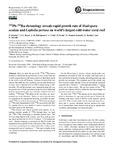<sup>210</sup>Pb-<sup>226</sup>Ra chronology reveals rapid growth rate of <i>Madrepora oculata</i> and <i>Lophelia pertusa</i> on world's largest cold-water coral reef
| dc.contributor.author | Sabatier, P | |
| dc.contributor.author | Reyss, J-L | |
| dc.contributor.author | Hall-Spencer, Jason | |
| dc.contributor.author | Colin, C | |
| dc.contributor.author | Frank, N | |
| dc.contributor.author | Tisnérat-Laborde, N | |
| dc.contributor.author | Bordier, L | |
| dc.contributor.author | Douville, E | |
| dc.date.accessioned | 2013-02-20T08:48:21Z | |
| dc.date.available | 2013-02-20T08:48:21Z | |
| dc.date.issued | 2012 | |
| dc.identifier.issn | 1726-4170 | |
| dc.identifier.issn | 1726-4189 | |
| dc.identifier.uri | http://hdl.handle.net/10026.1/1324 | |
| dc.description.abstract |
<jats:p>Abstract. Here we show the use of the 210Pb-226Ra excess method to determine the growth rate of two corals from the world's largest known cold-water coral reef, Røst Reef, north of the Arctic circle off Norway. Colonies of each of the two species that build the reef, Lophelia pertusa and Madrepora oculata, were collected alive at 350 m depth using a submersible. Pb and Ra isotopes were measured along the major growth axis of both specimens using low level alpha and gamma spectrometry and trace element compositions were studied. 210Pb and 226Ra differ in the way they are incorporated into coral skeletons. Hence, to assess growth rates, we considered the exponential decrease of initially incorporated 210Pb, as well as the increase in 210Pb from the decay of 226Ra and contamination with 210Pb associated with Mn-Fe coatings that we were unable to remove completely from the oldest parts of the skeletons. 226Ra activity was similar in both coral species, so, assuming constant uptake of 210Pb through time, we used the 210Pb-226Ra chronology to calculate growth rates. The 45.5 cm long branch of M. oculata was 31 yr with an average linear growth rate of 14.4 ± 1.1 mm yr−1 (2.6 polyps per year). Despite cleaning, a correction for Mn-Fe oxide contamination was required for the oldest part of the colony; this correction corroborated our radiocarbon date of 40 yr and a mean growth rate of 2 polyps yr−1. This rate is similar to the one obtained in aquarium experiments under optimal growth conditions. For the 80 cm-long L. pertusa colony, metal-oxide contamination remained in both the middle and basal part of the coral skeleton despite cleaning, inhibiting similar age and growth rate estimates. The youngest part of the colony was free of metal oxides and this 15 cm section had an estimated a growth rate of 8 mm yr−1, with high uncertainty (~1 polyp every two to three years). We are less certain of this 210Pb growth rate estimate which is within the lowermost ranges of previous growth rate estimates. We show that 210Pb-226Ra dating can be successfully applied to determine the age and growth rate of framework-forming cold-water corals if Mn-Fe oxide deposits can be removed. Where metal oxides can be removed, large M. oculata and L. pertusa skeletons provide archives for studies of intermediate water masses with an up to annual time resolution and spanning over many decades.</jats:p> | |
| dc.format.extent | 1253-1265 | |
| dc.language | en | |
| dc.language.iso | en | |
| dc.publisher | Copernicus GmbH | |
| dc.title | &lt;sup&gt;210&lt;/sup&gt;Pb-&lt;sup&gt;226&lt;/sup&gt;Ra chronology reveals rapid growth rate of &lt;i&gt;Madrepora oculata&lt;/i&gt; and &lt;i&gt;Lophelia pertusa&lt;/i&gt; on world's largest cold-water coral reef | |
| dc.type | journal-article | |
| dc.type | Journal Article | |
| plymouth.author-url | https://www.webofscience.com/api/gateway?GWVersion=2&SrcApp=PARTNER_APP&SrcAuth=LinksAMR&KeyUT=WOS:000302179500029&DestLinkType=FullRecord&DestApp=ALL_WOS&UsrCustomerID=11bb513d99f797142bcfeffcc58ea008 | |
| plymouth.issue | 3 | |
| plymouth.volume | 9 | |
| plymouth.publication-status | Published online | |
| plymouth.journal | Biogeosciences | |
| dc.identifier.doi | 10.5194/bg-9-1253-2012 | |
| plymouth.organisational-group | /Plymouth | |
| plymouth.organisational-group | /Plymouth/Faculty of Science and Engineering | |
| plymouth.organisational-group | /Plymouth/Faculty of Science and Engineering/School of Biological and Marine Sciences | |
| plymouth.organisational-group | /Plymouth/PRIMaRE Publications | |
| plymouth.organisational-group | /Plymouth/REF 2021 Researchers by UoA | |
| plymouth.organisational-group | /Plymouth/REF 2021 Researchers by UoA/UoA07 Earth Systems and Environmental Sciences | |
| plymouth.organisational-group | /Plymouth/Research Groups | |
| plymouth.organisational-group | /Plymouth/Research Groups/Marine Institute | |
| plymouth.organisational-group | /Plymouth/Users by role | |
| plymouth.organisational-group | /Plymouth/Users by role/Academics | |
| dc.identifier.eissn | 1726-4189 | |
| dc.rights.embargoperiod | Not known | |
| rioxxterms.versionofrecord | 10.5194/bg-9-1253-2012 | |
| rioxxterms.licenseref.uri | http://www.rioxx.net/licenses/all-rights-reserved | |
| rioxxterms.type | Journal Article/Review |


